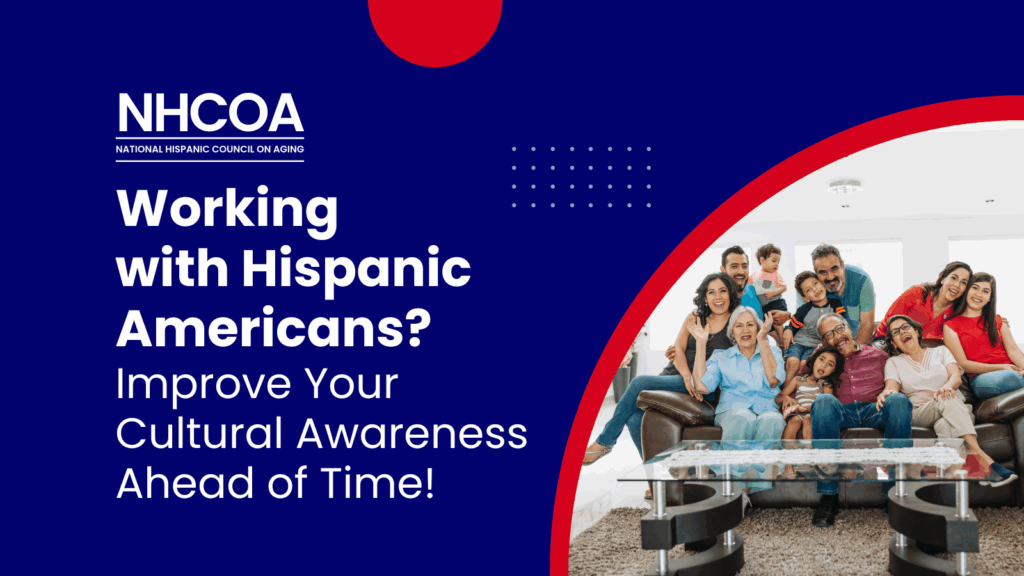
As the leading national organization working to improve the lives of Hispanic American older adults, their families, and their caregivers, NHCOA prides itself on understanding the intricacies of providing adequate and effective aid to Hispanic American older adults, and the greater Hispanic American community of the United States. The truth is that cultural and linguistic barriers far too often keep healthcare providers, aging networks, and similar nonprofit organizations from reaching Hispanic American communities.
The first step is always to get to know the demographic you’re trying to serve. The Hispanic American community in the United States widely varies and accounts for more than twenty different nations of origin. While many may speak Spanish, there are also Hispanic Americans whose primary language is English, Portuguese, or even such indigenous languages as Nahuatl. Everyone working at your organization or healthcare facility doesn’t need to know these languages, but translation services should be available, and hiring bilingual employees is an amazing step forward.
But even once you’re past the language barrier, there are plenty of cultural factors, which when properly understood, can be the difference in truly reaching patients and communities alike!
Familismo is one such value at the core of most Hispanic American households. There is a greater sense of dedication and loyalty to one’s family in Hispanic American households. When working with Hispanic American older adults, you’re likely to find that they are hesitant to make a decision without the input of their family. This comes into play even with important health matters, and especially with discussions around end-of-life care. Healthcare providers may be confused or frustrated at the pace of their decision making, but bear in mind familismo is a very strong cultural factor, that will especially come into play with multi-generational households which are common in Hispanic American communities.
Machismo is another factor that your organization is likely to encounter when serving Hispanic American communities. In some Hispanic American households, men may be dominant decision-makers in their marriages and households, and assume a dynamic where women are more submissive. It’s important to not react aggressively or defensively to these very personal dynamics, especially in healthcare settings where a bad interaction could influence the household’s adherence to medical advice.
Simple human connection plays a big role in their trust of medical professionals. Hispanic American communities tend to have a high degree of respect for medical providers, but there’s’ plenty of room for social complication. At a medical appointment, Hispanic Americans are likely to be very submissive to medical professionals, but depending on certain cultural factors, may not follow their guidelines once they leave the facility. That submissive tendency will often come off as shyness, keeping Hispanic American patients from asking questions and leading them to poor adherence of recommended treatments. The first step in ensuring proper care is eliminating any language barriers and approaching Hispanic American patients with kindness and patience for any cultural divide between them and the medical professional. Simple pleasantries like asking about their day can go a long way!
Faith is another big cultural factor within the Hispanic American community, which frequently comes into play in these healthcare related interactions. In fact, more than 90% of the Spanish-speaking world identifies as Roman Catholic. Hispanic Americans’ faith contributes largely to their decision making on such important matters as a loved ones’ last wishes and end-of-life care, as it relates heavily to such values as familismo and a general sense of respect, morality, and reservation.
If your organization or healthcare facility wishes to enhance its impact and outreach within the Hispanic American community, we encourage you to familiarize yourself with these cultural factors. Cultural awareness of Hispanic American households builds stronger, lasting connections with one of the largest demographics in the United States! For more tips on how to best work with the Hispanic American community, we encourage you to check out our webinar on the subject, titled “NHCOA’s ‘How to Successfully Engage and Work with Hispanic Americans’ Webinar,” on YouTube.
Need help? Contact NHCOA’s Resource Center, a multilingual hub that educates and empowers the Hispanic American community with accurate information and resources that can help them stay healthy. Available in English, Spanish and Portuguese! Text us via Whatsapp at (202) 658 – 8664. Learn more here: nhcoa.org/resourcecenter.
This publication is supported by the Administration for Community Living (ACL), U.S. Department of Health and Human Services (HHS) as part of a financial assistance award totaling $210,023 with 67 percentage funded by ACL/HHS and $70,240 amount and 33 percentage funded by non-government source (s). The contents are those of the author (s) and do not necessarily represent the official views of, nor an endorsement, by ACL/HHS, or the U.S. Government.

Recent Comments